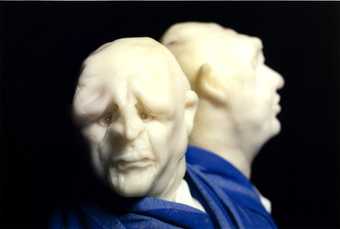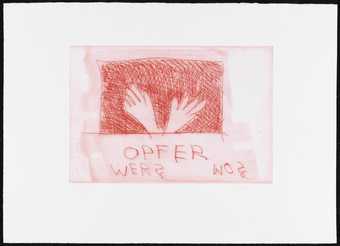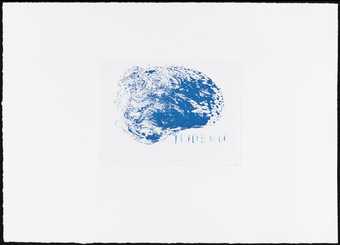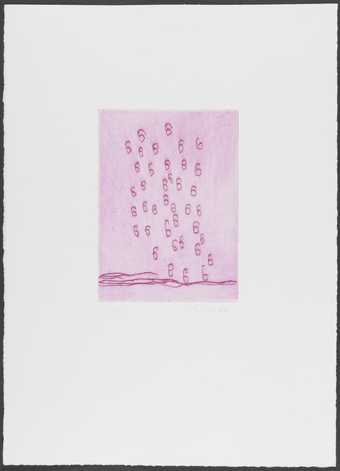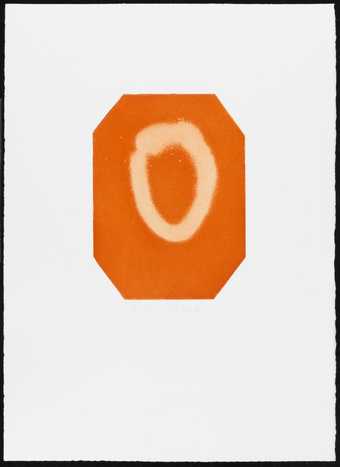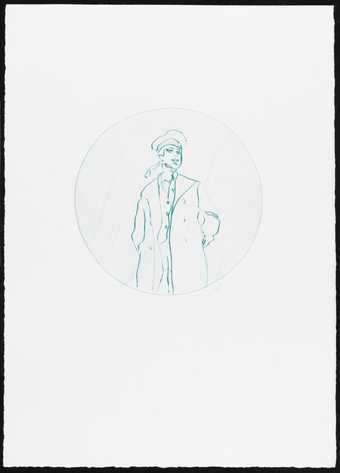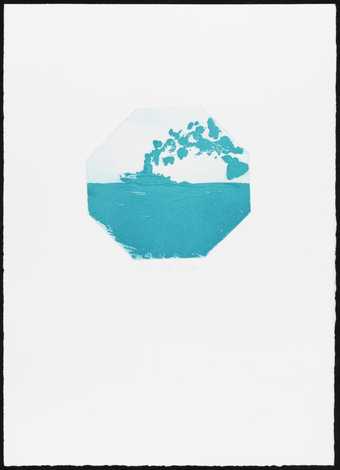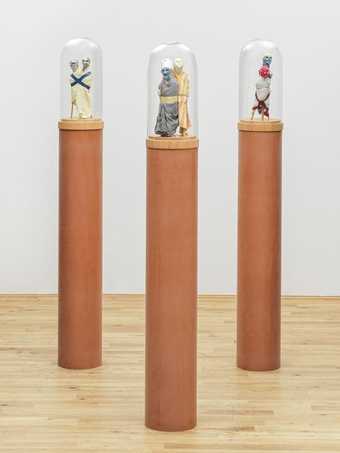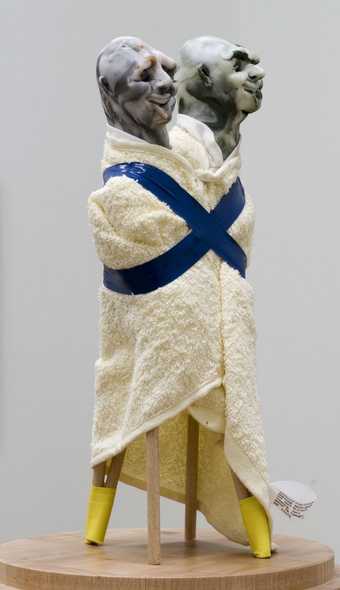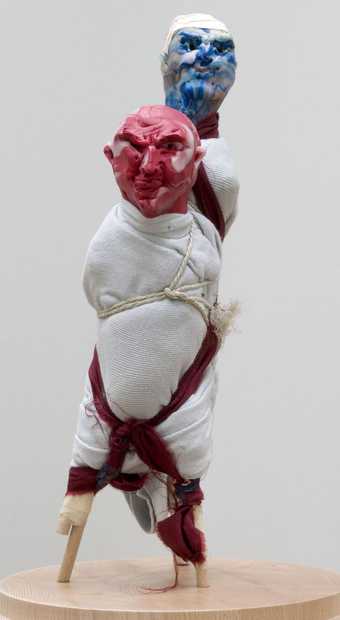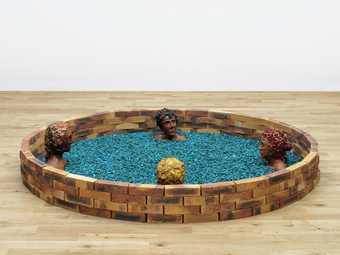Not on display
- Artist
- Thomas Schütte born 1954
- Original title
- Die Fremden
- Medium
- Ceramic
- Dimensions
- Object 1 Blue coat boy: 1587 × 510 × 485 mm, 257 kg
object 2 Yellow coat man: 1898 × 662 × 532 mm, 340 kg
object 3 Brown coat woman: 1821 × 622 × 540 mm, 304 kg
object 4 Green vessel: 1005 × 470 × 490 mm, 225 kg
object 5 Round blue vessel: 1158 × 660 × 660 mm, 196 kg
object 6 Yellow vessel: 1048 × 462 × 505 mm, 171 kg
object 7 Blue green vessel: 950 × 1568 × 533 mm, 179 kg
object 8 Brown vessel: 943 × 630 × 475 mm, 181 kg
object 9 Purple vessel: 820 × 570 × 570 mm, 181 kg - Collection
- Tate
- Acquisition
- Purchased 2002
- Reference
- T07873
Summary
The Strangers
comprises a group of nine large glazed ceramic objects representing three human figures, two pieces of luggage and five vases. They are part of a larger group of thirty figures Schütte created in response to a public commission by a department store occupying the Roten Palas, a building with a classical façade next door to the Museum Fridericianum in Kassel. The commission was timed to coincide with the 1992 Documenta exhibition, Documenta IX, and the figures were installed outside on the façade of the building above its pseudo classical columns. Schütte explained: ‘They wanted sculpture as a logo or traffic sign, but I immediately had this idea of putting people on the roof ... it was ... a very interesting site overlooking this place, and I immediately had this image ... of placing some colourful, static figures on top of the building as a permanent installation.’ (Quoted in Lingwood, pp.12-13.) He used terracotta because of the brilliant colours possible in glazing. Each life-sized figure was built up slowly, from the bottom upwards, over a period of seven days. The lower section was created using a rotating template to render it cyclindrical like the base of a pot. The upper sections were modeled in stages using thick wads and strips of clay, concluding with the head, which was sculpted very roughly in one day. Hair and other textures are stylized in the manner of archaic Greek sculpture. The colourful ceramic glaze was also applied quickly, resulting in splodges and drips. Because of their large size, the objects spent a week in the kiln. Each human figure was placed on a round ceramic base to compensate for shrinkage during baking. All the objects are attached to individual steel rectangles screwed to sections of wood to facilitate lifting. Installed out of doors on a balcony or flat roof, they are bolted to steel girders. For indoor installation, special plinths are made following the artist’s instructions. These are simple boxes constructed from plywood or blockboard with a raw unpainted surface. Each plinth is placed on a slightly bigger board standing on short sections of wood. This creates an effect of pallets and packing cases appropriate to the theme of travel and displacement. Schütte has commented:
Basically in 1992 the political dimension was changing every week – and all these issues are still unresolved. What defines a German, the passport, the blood, the country of birth, the language or the mentality?... The question was, are they arriving or departing, are they bringing something or taking something, and why are they here at all? What culture or attitudes or ideas do they carry with them? There is always the feeling that people who come from elsewhere are taking things away; that they are thieves. The eyes are cast down so that the figures have this shameful expression ... I think the luggage defines them as strangers.
(Quoted in Lingwood, p.13.)
Schütte studied under Gerhard Richter (born 1932) and Fritz Schwegler (born 1935) at the Düsseldorf Academy between 1973-81. His earliest works address architectural space, decoration and the construction of theatrical devices for the display of art. Until the mid 1980s his use of the human figure was mainly restricted to generalized silhouettes or cut-outs and readymade toy figures, providing generic representations of crowds of people or a reference to scale in a quasi architectural model. When he began modeling more individually expressive figures, Schütte struggled with the properties of the materials. Mann im Matsch
(Man in Mud) 1982 (collection the artist), Schütte’s earliest figurative sculpture, consists of a little figure immersed up to its knees in wax, a technical solution to its inability to stand up which became central to its meaning. Such crudely made heads and busts in clay as Mann und Frau (Man and Woman) 1986 (Chantal Crousel Gallery, Paris) and Alain Colas 1989 (Panza Collection, Lugano) include wood and polystyrene elements as an integral part of their portraiture. Other figures created at the end of the 1980s consist of caricatured heads modeled in Fimo or a similar child’s modeling clay and placed on three-legged supports made of sticks wrapped with old pieces of the artist’s clothing. In United Enemies 1993-5 (see Tate T07017-9), such figures are installed on cylindrical plinths under glass bell jars.
The human figures in Die Fremden mark a departure from Schütte’s earlier works. The manner of their construction emphasizes their status as homogenous, vessel-like objects rather than human subjects. This is accentuated by their installation now at eye-level indoors, where they have the appearance of oversized, glazed skittles or other old-fashioned children’s toys. In juxtaposition with the oversized pots which form part of the work, the human figures (whose features and costume are recognisably non-Western) are equated with them, suggesting that they are exotic objects displayed during the process of shipping from one place to another. At they same time they are sufficiently differentiated to suggest individual personalities. Tate’s group comprises a dark-haired man, a woman whose head is covered by a spotted head-scarf and a blonde-haired child. The remainder of the original group is split between a conference centre in Lübeck and the Museum Fridericianum in Kassel.
Further reading:
Julian Heynen, James Lingwood, Angela Vettese, Thomas Schütte, London 1998, pp.10-14, 98, reproduced pp.100-101 in colour
Thomas Schütte: Scenewright; Gloria in Memoria; In Medias Res, exhibition catalogue, Dia Center for the Arts, New York 2002
Thomas Schütte: [figur], exhibition catalogue, Hamburger Kunsthalle and Würtembergischer Kunstverein, Stuttgart 1994, pp.6, 46-52, reproduced pp18-19 in colour
Elizabeth Manchester
December 2003
Does this text contain inaccurate information or language that you feel we should improve or change? We would like to hear from you.
Explore
- abstraction(8,615)
-
- from recognisable sources(3,634)
-
- figure(2,270)
- formal qualities(12,454)
-
- ceramics(71)
- vessels and containers(2,157)
- actions: postures and motions(9,111)
-
- standing(3,106)
- child(1,324)
- lifestyle and culture(10,247)
- migration(20)
You might like
-
Thomas Schütte [no title]
1994 -
Thomas Schütte [no title]
1994 -
Thomas Schütte [no title]
2001 -
Thomas Schütte [no title]
2001 -
Thomas Schütte [no title]
2001 -
Thomas Schütte [no title]
2001 -
Thomas Schütte [no title]
2001 -
Thomas Schütte [no title]
2001 -
Thomas Schütte [no title]
2001 -
Thomas Schütte [no title]
2001 -
Thomas Schütte [no title]
2001 -
Thomas Schütte [no title]
1993 -
Thomas Schütte [no title]
1993 -
Thomas Schütte [no title]
1993 -
Thomas Schütte Four Sisters in the Bath
1989


